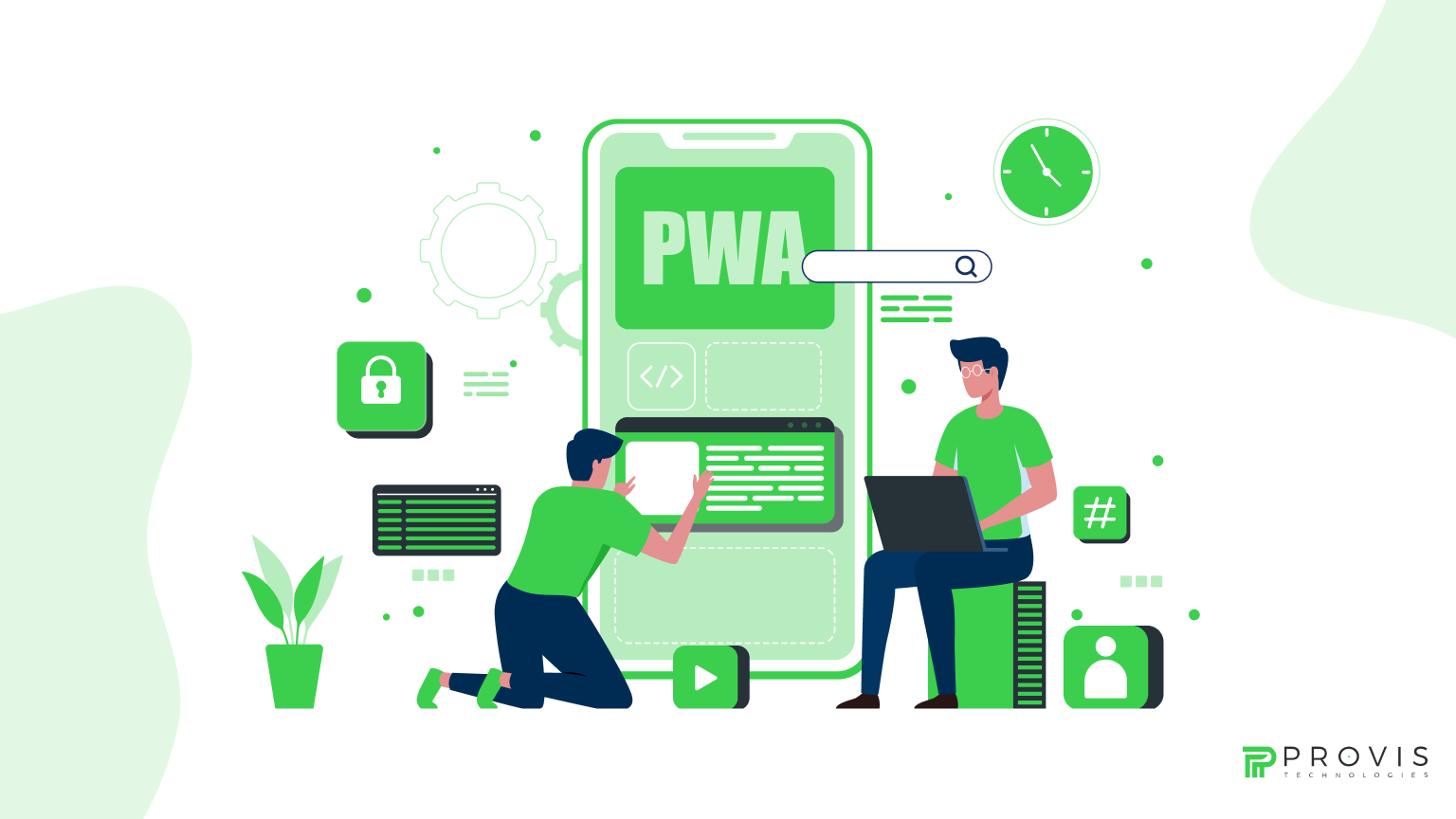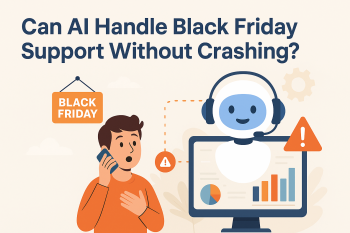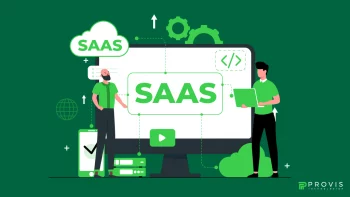Building an app in the present mobile-first scenario requires businesses to determine if a Progressive Web App (PWA) or a Native App should be their development choice. The selection between Progressive Web App vs Native Apps relies on business needs, audience traits, and technical development capabilities.
Mobile user growth forces people to expect applications that provide rapid delivery of reliable and seamless operations. A choice of incorrect application in PWA vs Native can reduce user interaction rates and maintain their usage while diminishing your financial results. This blog from Provis Technologies presents all essential information about Progressive Web App vs Native Apps, including their operational principles, advantages and disadvantages, to help determine which solution is the best.
What is a Progressive Web App (PWA)?
Modern web apps, known as Progressive Web Apps, enable users to use browser-based applications with native app features and interfaces. PWAs deliver an application experience through their design, which includes offline usability, push alerts and instant page loading.
The construction of PWAs depends on standard web technologies, including HTML, CSS and JavaScript. Moreover, users can access PWAs directly through browsers since they do not require store downloads.
Users lack the option to directly install PWAs, yet they can make shortcuts from the browser to place them on their home screen.
Key Features of PWAs
PWAs demonstrate their strongest characteristic through their offline functionality and their operation under substandard network conditions. The background operation of service workers allows important data to be stored in cache systems. Service workers enable users to keep using the app uninterrupted without an active internet connection.
The distinctive attribute of PWAs is their quick page loading. Using cached data enables PWAs to deliver fast performance on different networks to provide enhanced user experience while decreasing site abandonment.
The technology automatically adjusts and works with various screen dimensions and operating device types, including mobile phones, tablets, and personal computers.
Users can receive notifications through push notifications when using PWAs. The implementation of PWAs enables business-to-user communication, which drives both user interaction and maintenance rates while eliminating dependence on native application requirements.
The limitations of push notifications for PWAs exist because Apple implements restrictions on their devices.
What is a Native App?
Native Applications are mobile app development products specific to distinct operating systems where iOS software requires Swift or Objective-C coding, while Android applications function through Java or Kotlin programming.
The native app acquisition process involves users obtaining apps through direct downloads from stores that include Apple App Store and Google Play Store.
Native apps provide complete access to device features and capabilities because developers write them specifically for a platform which allows the use of camera, GPS features, microphone components, Bluetooth connectivity and fingerprint authentication capabilities.
Users benefit from faster performance while also experiencing better security while enjoying top-tier user experiences.
Key Features of Native Apps
Native apps deliver exceptional performance because their development uses operating system-specific code that enables optimized functionality.
Native applications deliver both improved performance and enhanced speed, as well as enhanced reaction times over PWAs.
The application achieves complete hardware and software accessibility through its platform. The camera function works through AR features and Bluetooth integration and GPS location services exist as native application capabilities.
The main benefit arises from working offline without facing any restrictions. Native applications become executable after download, even when users do not maintain a persistent internet connection. The push notification system in both Android and iOS provides businesses with a powerful tool to reach their users and create additional engagement opportunities.
Native applications demand special approval from app stores before publication becomes possible. The approval process extends the launching time while setting additional requirements but helps maintain high quality and secure standards.
Key Differences In Progressive Web App vs Native Apps
Understanding Progressive Web App vs Native Apps is a must for making an informed decision.
- Platform Dependency
In cross-platform development, a PWA can operate across any device which features a contemporary browser because these applications show independence from specific platforms. Native apps need specific development for each operating system, including iOS and Android, since they operate independently on platform terms.
- Installation and Access
The installation process of PWAs goes through browsers without needing any app store verification procedure. Users need additional time to complete app store installations when they require native apps compared to PWAs, which can be accessed directly from web browsers.
- Performance
During app performance comparison, the native apps exhibit superior functionality because developers specifically optimize them for the operating system they will run on. Web technologies used by PWAs tend to cause performance weaknesses when handling complex applications.
- Offline Capability
Offline operation is possible for both PWAs and native apps yet native apps possess complete offline capabilities which exceed PWAs that manage only cached data.
- Device Feature Access
The native apps receive deeper platform access to crucial device components such as GPS, camera, sensors and Bluetooth. PWAs limit their operating capabilities because browser security restrictions apply.
- Development and Maintenance Costs
The development expenses for PWAs stay lower because code written once serves multiple platforms. Native applications demand individual software development for each system, resulting in higher development expenses and longer maintenance requirements.
Advantages and Disadvantages of PWAs
Advantages of PWAs
- Lower development and maintenance costs.
- Works across multiple platforms with a single codebase.
- Faster deployment is possible since app store approval is not needed.
- Fast loading times and offline functionality.
- This system enables automatic updates that happen without requiring user involvement.
Disadvantages of PWAs
- Limited access to device features.
- The speed and performance of applications deteriorate when using complex designs.
- Push notifications receive restricted support in the iOS system.
- Application stores operate without visibility, which diminishes user discovery of these applications.
Advantages and Disadvantages of Native Apps
Advantages of Native Apps
- High performance and fast response times.
- Full access to device hardware and software features.
- Each application platform gets customized user experiences which optimize performance.
- Strong security due to app store regulations.
- Full offline functionality.
Disadvantages of Native Apps
- Higher development and maintenance costs.
- Application store review processes delay the release date of new applications.
- Users need to conduct independent downloads and independent updates through manual processes.
- Platform-specific development increases complexity.
When to Choose a Progressive Web App (PWA)
PWAs are ideal if:
- Your project operates under budget restrictions combined with the need for decreased development expenses.
- Your goal is to interact with numerous users who use different types of platforms.
- For improving user satisfaction, speed during load times and offline functionality play a vital role.
- Your application depends on content rather than extensive hardware capabilities.
The characteristics of PWAs favor their application to e-commerce sites as well as content-oriented websites and simple social media networks. PWAs deliver both quick service and cost-efficient maintenance to users.
When to Choose a Native App
Native applications should be selected as the optimal choice under the following circumstances:
- Performance and responsiveness are critical.
- Your application requires advanced device elements such as GPS and camera functions and sensors.
- Organizations prioritize data safety along with privacy protections at the top of their agenda.
- The goal should be to offer users a seamless platform-specific interface.
Individual apps work best for gaming platforms, financial services, health and fitness trackers and social media platforms because they depend heavily on device-level integration and require high-quality graphics performance.
Progressive Web App vs Native Apps: Which One is Right for You?
Your business needs to evaluate three factors, including business goals, budget and technical requirements, to determine whether PWA or native app suits you best.
- Your business should deploy a PWA when searching for a compact and budget-friendly application solution that works on multiple platforms.
- A native application provides superior device features, access, user experience, and better performance compared to PWA.
- A majority of companies initiate their mobile strategy with a PWA that serves as an initial market testing tool, which they later convert into native applications based on growing user requirements.
Your investment in this methodology enables you to reduce expenses while improving application performance and user experience in apps over time.
The Bottom Line
Modern mobile markets suit both native applications and Progressive Web Applications. Native apps deliver elite performance features and deep system integration, but PWAs provide extensive reach and economical operation.
A thorough understanding of the advantages and drawbacks of available options enables you to select a solution that matches your business needs while providing maximum usability to your users.
Written By
Author's Picks
- How Do Apps Make Money in 2025? 12 Best Strategies to Follow
- 20/12/2024
- What is Progressive Web Apps: Comprehensive Guide for 2025
- 20/11/2024
Categories
- AI for Startups
- AI in Web Development
- AI Integration
- AI Platforms
- AI Prompt
- AI Tools
- AI Trading Software
- Android App
- Android vs iOS Development
- Angular
- API
- API Development
- App
- app development
- App Idea
- App User Feedback
- Application
- Artificial Intelligence
- Audit Services
- Automotive Industry
- Awards and Recognition
- Business Consulting
- Business Website
- Chatbots
- CRM
- CRM for Financial Advisors
- Custom CRM
- Custom SaaS
- Custom Website
- Customer Service
- dashboard design
- Developing a Mobile App
- Digital Business
- E-commerce
- EMR Integration
- Finance
- Financial Advisors
- Financial Advisors
- GIT
- Health Insurance
- iOS App
- iOS App Development
- IoT Mobile App Development
- IoT Platforms
- IT Audit Services
- IT Consulting
- IT Strategies
- Java Development
- Laravel
- Lean Canvas
- Learning Management System
- Logistics Apps
- Mobile App Development
- MVP
- Native App
- News Aggregator Site
- OTT
- Outsourcing IT
- Payment Gateway
- predictive analysis
- Product Launch Strategy
- Progressive Web App (PWA)
- Prototype
- Recommender Systems
- Ruby
- SaaS
- SaaS Application
- SaaS Business
- SaaS Company
- SaaS Development
- SaaS Product
- SaaS Project
- Sales Funnel
- SEO
- Shopping Cart
- Software Development
- SSL and TLS
- Startup Checklist
- Technology
- Tetradic Color Scheme
- UI/UX Design Company
- Unit Testing
- User Flow
- User Testing
- Web Development
- Web Performance Optimization
- website Maintenance Services
- Website Migration Service
- Website Speed Optimization
- WooCommerce
- WordPress





